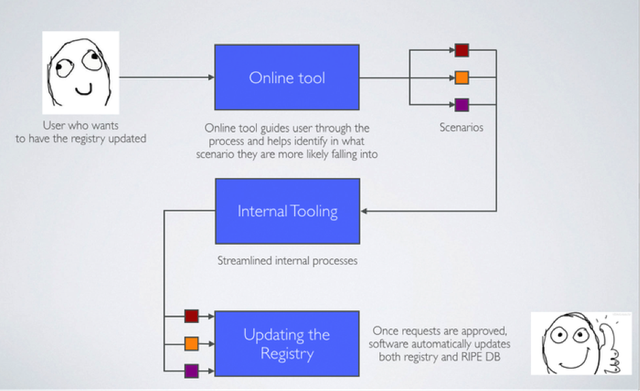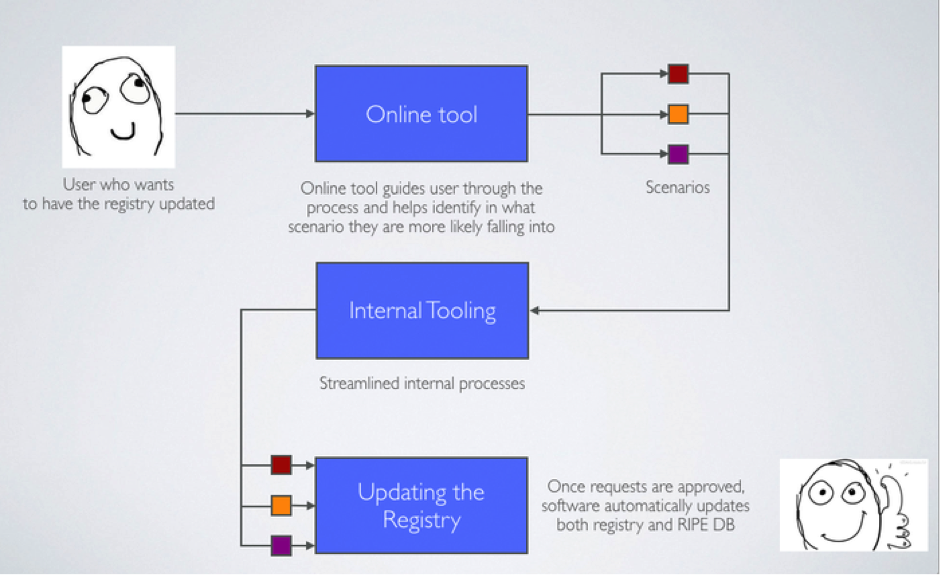Transfers of End User resources in the LIR Portal will soon be handled in the same way as transfers of LIR resources. This is part of our ongoing efforts to improve the user experience and security of the LIR Portal, while making our own processes more efficient.
At the moment, both the offering and receiving party can initiate a transfer of End User resources, doing so via an open text request form in the LIR Portal. There are a few problems with this, however. It limits the number of automated checks that we can perform. It also introduces security risks and makes the whole process more prone to errors. Some issues that can arise include:
- The resources may have been transferred in the past 24 months, which means they are not eligible for transfer under RIPE policy.
- If it’s a transfer from one End User to another, the sponsoring LIR acting on behalf of the receiving party might initiate the transfer before they have officially become the new sponsoring LIR. This can make it unclear who is actually representing the End User.
- Transfer requests for the same resources can be submitted by multiple LIRs at the same time. This can cause delays, confusion and disagreements between the parties involved.
To avoid these issues, we will soon be applying the same system that is already in place for transfers of LIR resources. Only the holder of the resources (in this case the sponsoring LIR) will be able to initiate the transfer to another party, by selecting the resources in the LIR portal. There are important advantages to this:
- Only resources that are eligible for transfer can be selected
- Typos in IP prefixes are not possible
- Transfer requests are submitted to us in a standardised format
- Multiple transfer requests for the same resources cannot be submitted
We anticipate that in a small number of cases, the sponsoring LIR may be unresponsive or uncooperative, which could create issues for the End User looking to transfer their resources. If this is the case, the End User can always find a new sponsoring LIR and sign a contract with them. We believe that the potential for these kinds of complications is far outweighed by the benefits in terms of added security and efficiency that this alignment between LIR and End User transfers will introduce.
Part of a Larger Approach
Allocation, assignment and transfer requests used to be handled through email-based request forms. These were phased out in June 2015 and represented our first step towards standardising and automating these processes. We have initially focused on improving the process for resource transfers – this is the most logical approach, as these requests take up a large percentage of the time and resources of the Registration Services Department. The image below provides a high level overview of this approach.

Standardising and automating registry updates
Ultimately, our goal is to cover all possible scenarios that involve requests for registry updates submitted via the LIR Portal. This latest development is another step towards an easier and more secure system. As always, we welcome any feedback on this latest development and how we can continue to improve.




Comments 3
The comments section is closed for articles published more than a year ago. If you'd like to inform us of any issues, please contact us.
Tomasz Ludwiczak •
"Only the holder of the resources (in this case the sponsoring LIR) will be able to initiate the transfer to another party, by selecting the resources in the LIR portal." This approach, incase of transfers of LIR resources is correct, but for End User resources, the transfer initiation should be on the receiving LIR side. What will the transfer be like in practice? EndUser will contact the actual LIR that he want to terminate aggrement with? End User will submit to actual LIR a new contract that it has entered into with the new LIR? The LIR who maintains resources will have access to the contract concluded by EndUser with the new LIR? Transfer initiation should be on the LIR side of the receiving resource. Very often it happens that EndUser does not have a good contact with the current LIR, so it decides to change. Can you write something more about how the transfer process will look in practice step by step? Maybe my doubts will be dispelled.
Joop Wiss •
Dear Tomasz, Many thanks for your comment. You wonder what the transfer will be like in practice. Well, this is actually a situation which occurs all the time already. When an end user wants to transfer their resources to another party, the current sponsoring LIR submits this transfer request on their behalf. There are multiple scenario's possible: 1. End user wishes to transfer their resources to an LIR (either their current sponsoring LIR or another LIR). 2. End user wishes to transfer their resources to another End User and both End Users are sponsored by the same LIR. 3. End user wishes to transfer their resources to another End User who is sponsored by another LIR. Depending on which scenario applies, different documents will be needed: 1. We will need to see a Transfer Agreement and copies of recent registration documents of both parties. 2. We will need to see a Transfer Agreement, recent registration documents of both parties and an end user assignment agreement between the receiving end user and the same sponsoring LIR. 3. We will need to see a Transfer Agreement, recent registration documents of both parties and an end user assignment agreement between the receiving end user and the new sponsoring LIR. Please note that the current sponsoring LIR doesn't need to be the one to provide the new end user assignment agreement if there is a new sponsoring LIR involved. If there is an issue with the contractual privacy we will approach the new sponsoring LIR for the agreement. You mention that it very often happens that an end user does not have a good relation with their current sponsoring LIR. It is our experience that there is actually only a very small percentage where this plays a part in the transfers that we receive. In the rare cases that this happens, the end user is free to find a new sponsoring LIR first and then submit the transfer request via their new sponsoring LIR. I hope this answers your questions and makes the process more clear. Kind regards, -- Joop Wiss IPRA
Tomasz Ludwiczak •
Many thanks for such a detailed answer. It seems to me right now that I have mistaken ad.1. End user wishes to transfer their resources to an LIR (either their current sponsoring LIR or another LIR).) with "Termination of Contractual Relationship Procedure" described https://www.ripe.net/publications/docs/ripe-688, which is not a transfer but Sponsor LIR change.